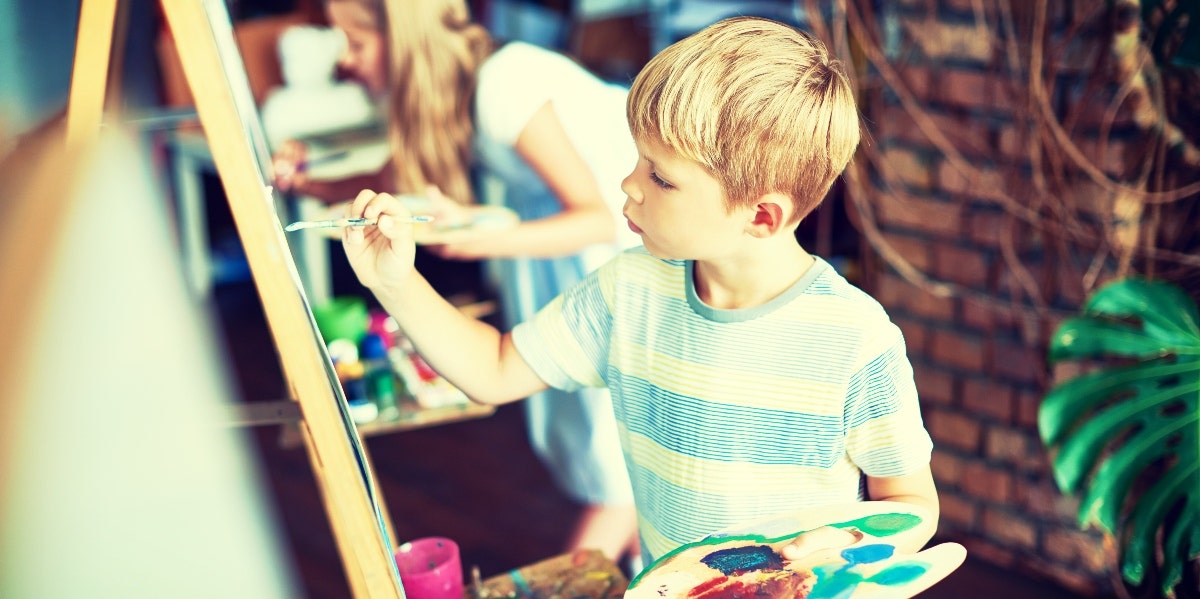Why Art Therapy For Kids Is More Than Just Arts & Crafts
Children benefit from art therapy.
 getty
getty It’s important to define art therapy and distinguish this healing modality as its own profession from what it’s not.
Creating or engaging in art may be described by some as "feel-good art and crafts," promoting relaxation, a mindful or spiritual experience, a distraction or chance to "numb" things out, or even a self-soothing tool when used as a form of personal "self-help" therapy.
While it should be encouraged for all to engage in the arts in any way, art therapy is a much deeper experience that cannot be completed on one’s own. In fact, it's rather unique and powerful, especially for children.
RELATED: 9 Mental Health Apps That Can Help Kids & Teens With Anxiety & Depression
Art therapy is a mental-health profession and an expressive art form. Clients use art media, the creative process, and the resulting product to explore their thoughts and feelings.
So, what is art therapy, exactly? Here are 5 ways to define it.
1. Purposeful within a dynamic relationship
Each directive or intervention is meaningful and required to be done with a practitioner.
2. It's intentional.
It actively helps you visually express and record experiences, perceptions, feelings, and imaginations while eliciting an inherent capacity for art-making to enhance your physical, mental, and emotional well-being.
3. It's insightful.
Art therapy helps you gain insight and self-awareness, awakening your own capabilities to resolve and reconcile conflicts and problems. It helps to facilitate change, revealing individual differences.
Art therapy also assists with developing interpersonal, physical, cognitive, emotional, and social skills for healthy communication such as:
- Managing behavior and addictions
- Improving reality orientation
- Reducing stress
- Increasing self-esteem and expression
- Facilitating change
4. It comes from reparative and corrective non-judgmental roots.
The singular goal of art therapy is improving and restoring your functioning and sense of personal well-being. This is accomplished via directives and interventions that externalize your inner world in a safe environment.
New experiences are provided, even after product completion. Art therapy focuses on process versus product and right- or whole-brain integration.
5. It's a continuum of practice.
With art as therapy at one end and art psychotherapy at the other, it’s projective and introspective. This means that you're able to connect and relate to others, as well as yourself through art.
What are art therapists?
They are professionals who hold a degree in art therapy or a related field and are credentialed by the Art Therapy Credentials Board.
Registration (ATR) is granted upon completion of graduate-level education requirements set by the American Art Therapy Association and one-thousand post-graduate hours, or through supervised experience by another art therapist.
Art therapists work with people of all ages and impairments in a variety of settings, including hospitals, rehabilitation, psychiatric, medical, residential, educational, and assisted-living facilities, as well as in private practice.
They leverage their clients’ inherent capacity to creatively enhance their physical, mental, and emotional well-being, as well as their ability to self-express.
They've been trained and are skilled in applying various media — drawing, painting, sculpture, and myriad other art forms — and the creative process, and versed in human development, psychological, and counseling theories and techniques for assessment and treatment.
Art therapists are mindful of material and medium choice and application. They notice their clients’ responses and reactions during the creative process by being curious.
They are trained in insight-oriented questions to inform well-timed interventions, especially with children. Art therapists have developed specific directives and interventions to use at initial, middle, end stages of treatment.
When utilized with children, art therapy is important due to these 6 reasons.
1. Natural.
It's built on drawing, playing, and pretending, which are all a part of the "work" of children and their development.
2. Creative.
Art therapy encourages and enhances purposeful narratives by allowing storytelling via metaphors.
Children use art to communicate and record their experiences in a non-literal way using familiar and comfortable language.
3. Sensory-based.
It allows communication on many levels — visual, tactile, and kinesthetic. This helps kids feel seen and heard.
4. Non-verbal and safe.
Art therapy serves as a safe vehicle for communicating experiences when words are not enough, too difficult to express, or are even unavailable due to crisis, stress, or anxiety.
Since it lowers defenses and slowly releases disturbing experiences, art is a healthy way to cope compared to holding pain inside.
5. Connective.
By engaging their emotional brain, art promotes positive behavior and emotions.
It lights up parts of the brain that are still available to use after a crisis and helps us understand quickly that there is actually something we can do to feel better, at the moment.
6. Open-ended and insight-oriented.
Art therapy helps with integration and allows for curiosity and reflection, which leads to informed interventions and goals.
Kids respond to indirect questions and statements such as:
- "I wonder…"
- "I notice you’re…"
- "I see that…"
You don’t need to be an artist to benefit from art therapy. It just takes an appreciation for imagination, creativity, and a more dynamic way of viewing yourself and healing.
Gina Balit is a licensed marriage and family therapist and a registered art therapist, working in a private practice setting in Woodland Hills. If you have any questions, please reach out.
